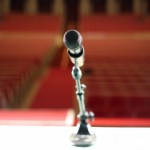The use of QR codes at meetings has exploded over the past several years, with organizations incorporating the scannable, information-containing technology into everything from games to advertisements — a progression that has been helped along by the growing popularity of smartphones, which can easily download QR-code scanners. (Read Convene’s previous assessment of QR codes in our September 2012 issue.)
But as two recent meetings demonstrate, attendee adoption isn’t a given.
At the Cardiovascular Research Foundation’s (CRF) Transcatheter Cardiovascular Therapeutics (TCT) conference, for example, the world’s leading cardiologists attend a program that includes an expansive poster session. Last year’s TCT, held at the Miami Beach Convention Center on Oct. 22–26, featured nearly 800 poster abstract presentations on a variety of topics, from diabetic patients to stents to congenital heart disease.
In 2010, CRF began printing QR codes on each of the presentations. “We put the poster boards up with a small QR code on them, in the lower-right-hand corner,” said Fun Lee, CMP, director of meeting planning for CRF’s Center for Education. “Then if someone wants to know a little bit more, they can click on it and have more information sent to them” immediately via their electronic device.
But while the codes allow for the easy dissemination of information to TCT attendees, there’s one problem. “The people aren’t really going for it,” Lee said. “In that poster-session arena, … there are so many posters [and] there’s a lot of stuff going on. It gets lost in the shuffle, I think.” At last year’s meeting, Lee estimates, the poster QR codes got about a thousand clicks — from more than 11,000 attendees.
QR codes fared better at the Catholic Health Association of the United States’ (CHA) 2012 Catholic Health Assembly, held June 3–5 at the Philadelphia Downtown Marriott. CHA pre-prints name badges that contain QR codes, which are scanned at registration, checking attendees into the meeting. CHA has also devised a system of using codes to distribute its resources to attendees, who can scan them on demo products — such as books, posters, and CDs — that CHA offers to members, creating an order in its database. Selected materials are then shipped straight to attendees’ offices — usually arriving by the time they return to work.
“It used to be that we took quite a large amount of inventory of the products to the meeting,” said Janey Brummett, CAE, CHA’s senior director of technology. “… Now we’ve reduced the cost of having to ship all that to the meeting and ship leftovers back.”
CHA also uses QR codes as a lead-retrieval system for its exhibitors, something it beta-tested in 2012 and will expand on at this year’s meeting in Anaheim. “As opposed to an attendee either having to fill out a slip or drop their business card off to exchange their information, or if the exhibitor has some sort of giveaway,” Brummett said, “they can simply get scanned” using an iPhone or iPod Touch.
‘They’ll Click Whatever They Have To’
“If there’s a need, people will go for it,” said the Cardiovascular Research Foundation’s Fun Lee, CMP, regarding the use of QR codes at TCT. “If people want information, they’ll click whatever they have to. But if it’s just not that important or they can get it elsewhere, people aren’t going to click it.”
This seems to be the key. Are you providing an experience or service for your attendees with your technology that they can’t get anywhere else — and that will enhance their experience at your meeting? Successful adoption of QR codes, according to the Catholic Health Association’s Janey Brummett, CAE, “benefits the attendee and the association.”



